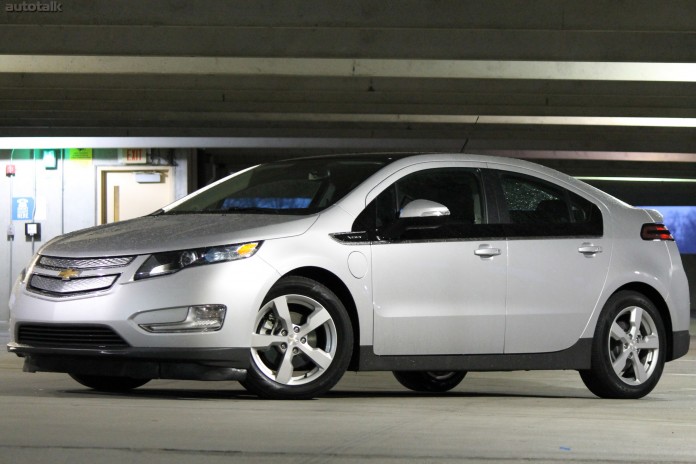Within the automotive world, there are two camps. One lives, breaths and dreams by the internal combustion engine and its screaming, gas snorting, road ripping abilities. They stand by it so much so, that they couldn’t be bothered with any other option. The other grouping firmly believes that these man-made soul cleansers are a big contributing factor to a big problem and that in general, it should be ditched so that something else can be developed. For the most part, these two circles of engineers, dreamers and thinkers tend to find it difficult to get along and each has their own valid points. In an attempt to break the schism and bring gearheads and electric vehicle folk together, General Motors began work on something the mid 2000s. When the 2011 model year came around, their potential answer made it into the hands of the public and now, the 2012 Chevrolet Volt has made it into the hands of us.
At this moment, the electric vehicle can only operate as city transportation. Despite claims from Mitsubishi, Nissan and Ford of a nearly 100 mile driving range, most charges can garnish anywhere from 70 to 50 miles depending on driving habits. Simply put, if you were to try to drive a LEAF or an i-MiEV halfway across the country or further, it would take a rather long time. That fact right there is a big point usually made by the proponents of the internal combustion engine, which has a driving range of well, whatever. Filling up with fuel takes less than five minutes and can return (depending on the car) up to 1,000 miles of uninterrupted driving. “Filling up” an EV can take a day and return perhaps 100 miles even though its carbon foot print is greatly lower compared to the average gasoline burning vehicle. In order to have the best of both worlds, a consumer could buy a Nissan LEAF and a Toyota Camry, use the LEAF for their short, daily commute and then take the Camry to see the in-laws in Florida. Or, they could buy a Chevrolet Volt.
GM and Chevy’s electric vehicle development program that created the Volt got its start around 2006 when the company’s then Vice Chairman, Bob Lutz, received some inspiration. With his team at his side, work began on an electric car that wouldn’t necessarily be an electric car. The biggest deterrent held by the public towards the EV is charging and range anxiety, so GM set about to create an alternative that wouldn’t cause panic when a plug was out of sight. Perhaps taking a lot of inspiration from the world of locomotives, the final product gets its motivation from three key components: a lithium-ion battery pack, an electric motor and an internal combustion engine. Like a train, the Volt’s main mode of movement is provided by the electric traction motor which drives the front wheels. Energy to power that electric motor can be had from three outcomes: the electricity solely from the Michigan built lithium-ion battery, the generator fed by the 1.4 liter internal combustion engine or a combination of the two. If fully charged, the Volt can be a total zero emissions EV but for the most part, it operates as a series hybrid vehicle as the engine supplies power to the generator which spins the electric motor thus pushing the sedan around.



As the Volt sits, it can be seen as a combination of both an EV and a Car, essentially a locomotive turned into a sedan. Chevrolet likes to call it an “Extended Range Electric Vehicle”, but nevertheless, it still needs to be a car. In order to find out just how innovative the Chevy really is, we got out hands on a 2012 bathed in Silver Ice Metallic. Only in its second model year, the Volt has already received a variety of updates, a few of which came to be due to the NHTSA fire fiasco that took place late 2011. Pricing for the car can get confusing but putting numerous tax credits aside, the base MSRP for the Volt is $39,145 without destination. Our tester came with one of just two option packages: the $1,395 Premium group which adds perforated leather seats with heating for the front, a leather wrapped steering wheel and special door trim. For $695, a rear view camera can be equipped but our Volt lacked the option which gave it a final price of $41,390 with destination charge. That number can be dropped and very much so depending on where in the U.S. a car is purchased. A Federal Tax Credit of $7,500 is still available and in some states like Colorado, a local credit of $6,000 can be had. This means that both the federal and state government want you to buy a Volt and in some cases, a brand new example can be had for around $27 grand.
Forgetting all of the incentives, $40,000 is a lot of cash for a car, especially one that dimensions wise, is a compact. Oddly enough, that price isn’t there simply to justify the drivetrain’s cost as the Volt has premium feel about it. Inside, the materials used for the trim, including the plastics, don’t appear to be the stereotypical GM. The steering wheel is perfectly placed and just the right size while the seats are beyond comfortable. Finding the right driving position is easy but is not done so via power adjusters. Visability is fine, even for a car with such a low-slung profile and overall, there is a sense of progression that wafts around. This is especially the case at night when the ambient lighting and “green” color scheme to dash spark thoughts of what the 1970s thought the future would be like. The progression rages on when one goes to change the radio station as almost every button on the center console is not a button. Instead, the flat panel houses touch sensors that are surprisingly responsive. They may seem novel and act quickly, but there is a question of their life span and repair costs down the road that has yet to be answered. Getting to know the Volt can either take a while, or if pressed for time, the Chevy can simply be grabbed and taken. This is easily the most remarkable aspect of the car as there was zero question as to how it operated and zero anxiety about if it would continue to move. When we first met the Volt, we opened the door, adjusted the seat, turned it on and backed out of the driveway. It wasn’t until the next morning that our curiosity got the best of us.



When initially turned on, the Volt greets its driver with a charming tune and far too many green leaves. Despite being rather boisterous at first, the car quickly quiets down to being utterly silent. There are two modes, on or off, so when sitting still to peruse the navigation or settings, the Volt can be placed into reverse (if your foot’s on the brake) by your passenger without your knowing. A small knob on the left of the steering wheel can activate the tutorial mode which will give you all the information you need to understand the display. This is a smart first step to take and shows what each segment of the display means. At all times, the Volt will openly showcase its potential driving range regardless of how it’s getting its motivation. There is even a little green ball that indicates the efficiency level or your driving. If floored, the icon shoots up and turns an ugly orange, indicating aggressive and inefficient acceleration. If the brakes are slammed on, the ball drops and becomes orange again to indicate poor stopping. There are three driving modes, Normal, Sport and Mountain. Normal is the default but the other two can be selected at any time via a large, “Driving Mode” button on the center dash. In all honestly, not much of a difference was felt between the three so we simply kept it normal. The seven-inch digital center display shows radio and audio options, navigation, climate and power distribution. This allows occupants to stare and see whether or not the Volt is using its battery, engine or both for power.
There is a lot of negative belief that a EV has to be slow, but that simply isn’t the case. There is a reason why locomotives, which are given the task of hauling tons of weight across nations use electric traction motors and its called instantaneous torque. Powering the front wheels of the Volt is a 111 kilowatt motor with 149 horsepower and a startling 273 lb-ft of torque. With output like that, the Volt can and will spin its tires despite its heavy, 3,781 lb curb weight. Power is supplied by either a 435 lb, 5.5 foot, 16 kilowatt hour lithium-ion battery or a 84 horsepower, 1.4 liter gasoline burning four cylinder engine. Each supply system has to burn something and those somethings are either electricity or dinosaur blood. To operate as a fully electric, zero emissions car, the supplied 110 volt charger housed under the trunk mat can fill the battery up with energy. Chevrolet says that a full charge can be had using a household, 120 volt outlet in 10 to 12 hours; basically overnight. If filled up, an EPA estimated 35 miles can be had in zero emissions mode but that’s all dependent on how the Volt is driven. We plugged our tester up overnight (not a full 10 hours) and in return, we were given 27 miles of utterly quiet driving.
Unlike the select and rather small group of Americans who drive that little, we are placed directly in the middle of urban sprawl central and thus, drove more that 30 miles in one day. When that allotment was up, the switch over to series hybrid mode went almost unnoticed. The Volt didn’t warn or beep hysterically, it simply did what it had to do and kept on moving. The only change was seen on the dash display as the driving range indicator showcases a little fuel tank instead of a battery. After about a quarter or a mile however, a change could be heard as the 1.4 liter engine is, putting it bluntly, buzzy. Perhaps due to it running in Open Loop, the engine does make an unpleasent sound that takes away from the unconventional luxury that riddles the rest of the Volt. Even still, the engine’s unrefined nature gets forgiven when a driver does something usually not associated with EVs, take a corner at a fast pace. In the past, we have stuck our noses in air when it comes to electric assisted steering but in the Volt, it operates and feels like a more traditional hydraulic unit. Turn in is strangely quick and feedback actually exists. The chassis is so smooth that it must have gotten help from the team who built the Lambda SUVs and there was never an instance where the suspension crashed or felt uncomposed. All a driver has to do is stomp on the throttle and turn the wheel and what is produced is something never thought possible out of an alternative vehicle: a smile. It is a big disappointment then that the tires do the chassis zero justice. They were designed to return high fuel economy and thus, have a low rolling resistance and squirm and squeal when pushed. The reason makes sense when after all, who is going to autocross a Volt?
Here is a confession: of the two aforementioned automotive camps, this driver subscribes to the fuel chugging, fire-spitting, hot-rod variety. Despite the ownership of a vehicle with an aftermarket exhaust, the Volt was found to be endearing and at times, charming. Chevrolet has done an absolutely fantastic job with their latest star as it carries a feel of quality thought not to exist in a GM product outside of a Corvette. Blame can perhaps be put on too much development and investing into the Volt (i.e. the Vette) but at the end of the day, the work can be felt and seen. The electric Chevy is a very handsome looking sedan, an uncommon trait of most hybrids and EVs, and many passers-by mentioned it looked like it spent a lot time in a wind tunnel. As a car, the Volt is hands down, one of the best GMs in recent history but the story changes when other slightly more real factors come into play. It may average an EPA estimated 60 mpg combined (electric and gas mode), but the real world can drop that number like a rock. We saw 39 mpg with our journalist feet which can be beaten by a conventional and much cheaper Hyundai Accent. With tax credits, $30,000 seems okay for the car, but without them, $40,000 is far too much for something without power seats and those credits are not going to be around forever. For that reason, Chevy is currently having trouble selling the vehicle, so much so that they had to pause production to thin out their inventory. As an answer to the alternative vehicle question, the Volt isn’t the best response but that doesn’t mean it is a bad car. In reality, it is an excellent example of what proper time and development can do for a vehicle and if comfortable, luxurious, entertaining and efficient driving is up your ally, then the 2012 Chevrolet Volt should not be ignored. Afterall, it has ever so slightly changed the thinking of one skeptical gearhead.























[…] 2012 Chevrolet Volt Review Instead, the flat panel houses touch sensors that are surprisingly responsive. They may seem novel and act quickly, but there is a question of their life span and repair costs down the road that has yet to be answered. Getting to know the Volt can … Read more on AutoTalk […]
[…] 2012 Chevrolet Volt Review Only in its second model year, the Volt has already received a variety of updates, a few of which came to be due to the NHTSA fire fiasco that took place late 2011. Pricing for the car can get confusing but putting numerous tax credits aside, … Read more on AutoTalk […]